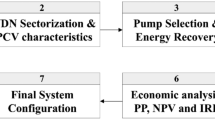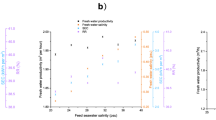Abstract
The use of windmills for the pumping of well water has appeared economically feasible in regions with average winds above 5 m/s, and when the water is used for human consumption and irrigation in arid rural zones, the importance of extracting the water from these wells efficiently and sustainably becomes more evident. However, concerning the state of Ceará/Brazil, only 18% of the drilled wells are freshwater wells, thus requiring additional energy for the utilization of desalination systems such as reverse osmosis. For that, the correct sizing of the pumping system associated with water desalination systems is essential, bearing in mind that the knowledge of the performance curves of the windmills, usually associated with piston pumps, is the “key factor” of the project. A brief analysis of the literature and websites of windmill suppliers shows that the performance curves of windmills associated with piston pumps are scarce, and the procedure to obtain them is not clear. This work’s novelty is to use the windmill’s power coefficient curve in association with the piston pumps to obtain the windpump performance curves, as pressure head versus volumetric flow rate in different wind conditions and sizes of windmills. The obtained curves were compared with other two curves found in the literature: one in a supplier’s catalog and another from the “rule of thumb”. The results showed a considerable divergence when calculating the root mean square deviation: 43.73% in relation to the supplier data average, and 125.76% in relation to the rule of thumb average results; however, the model proposed herein presented a limited operational range, which was not verified in the other two curves, which reproduced unlimited machines in terms of provided pressure head and flow rate. The unreal and asymptotic characteristics are more evident in the curves obtained by the rule of thumb, where the differences are also greater (125.76%) in relation to the proposed model. In terms of freshwater production, the model proposed herein reached, with an average wind speed of 6.5 m/s, and with a windmill of 6.1 m in diameter, a flow rate of up to 9.1 m\(^{3}\)/day, after going through the reverse osmosis system. The same condition with the rule of thumb’s model reached a flow rate of up to 11.3 m\(^{3}\)/day. Finally, the model proposed herein for obtaining windmill’s performance curves proved to be easy to implement and with realistic results, becoming an important design tool.












Similar content being viewed by others
Abbreviations
- \(A_{0}\) :
-
Transversal area of the windmill (\(\mathrm{m}^{2}\))
- \(A_{b}\) :
-
Transversal area of the pump piston (\(\mathrm{m}^{2}\))
- C :
-
Concentration of salts (\(\mathrm{mg}/\mathrm{L}\))
- \(C_{a}\) :
-
Feed water salts concentration (\(\mathrm{mg}/\mathrm{L}\))
- \(c_{p}\) :
-
Windmill power coefficient (−)
- \(C_{pe}\) :
-
Permeate water salts concentration (\(\mathrm{mg}/\mathrm{L}\))
- \(C_{r}\) :
-
Waste water salts concentration (\(\mathrm{mg}/\mathrm{L}\))
- D :
-
Pipe diameter (\(\mathrm{m}\))
- \(D_{j}\) :
-
j’s component’s diameter of Sect. 1 (\(\mathrm{m}\))
- \(D_{k}\) :
-
k’s component’s diameter of Sect. 2 (\(\mathrm{m}\))
- \(f_{j}\) :
-
Darcy friction coefficient of j’s components (−)
- \(f_{p}\) :
-
Polarization factor of the membranes (−)
- g :
-
Gravity acceleration (\(\mathrm{m}/\mathrm{s}^{2}\))
- h :
-
Head (\(\mathrm{m}\))
- \(h_{b}\) :
-
Pump’s head (\(\mathrm{m}\))
- \(h_{i}\) :
-
Punctual i’s heads (\(\mathrm{m}\))
- \(h_{j,pd}\) :
-
Major j’s losses of Sect. 1 (\(\mathrm{m}\))
- \(h_{j,pl}\) :
-
Minor j’s losses of Sect. 1 (\(\mathrm{m}\))
- \(h_{k,pd}\) :
-
Major k’s losses of Sect. 2 (\(\mathrm{m}\))
- \(h_{k,pl}\) :
-
Minor k’s losses of Sect. 2 (\(\mathrm{m}\))
- \(h_{sys}\) :
-
Total head required by the system (\(\mathrm{m}\))
- \(h_{sys1}\) :
-
Head required by Sect. 1 (\(\mathrm{m}\))
- \(h_{sys2}\) :
-
Head required by Sect. 2 (\(\mathrm{m}\))
- \(K_{j}\) :
-
j’s component’s minor losses coefficients of Sect. 1 (−)
- \(K_{k}\) :
-
k’s component’s minor losses coefficients of Sect. 2 (−)
- \(K_{per}\) :
-
Permeability coefficient of the membranes (\(\mathrm{m}/(\mathrm{Pa.s})\))
- \(L_{j}\) :
-
j’s pipes length of Sect. 1 (\(\mathrm{m}\))
- \(L_{j,equ}\) :
-
j’s component’s minor losses equivalent length of Sect. 1 (\(\mathrm{m}\))
- \(L_{k}\) :
-
k’s pipes length of Sect. 2 (\(\mathrm{m}\))
- \(L_{k,equ}\) :
-
k’s component’s minor losses equivalent length of Sect. 1 (\(\mathrm{m}\))
- n :
-
Rotation of the windmill’s rod actuation axis (\(-\))
- P :
-
Manometric Static Pressure (\(\mathrm{Pa}\))
- \(P_{i}\) :
-
Manometric Static Pressure of i’s points (\(\mathrm{Pa}\))
- \(\overline{P}_{hb}\) :
-
Hydraulic power of the pump (W )
- \(\overline{P}_{md}\) :
-
Mechanical power provided by the windmill (W )
- \(\overline{P}_{mr}\) :
-
Mechanical power required by the pump (W)
- Q :
-
Volumetric flowrate (\(\mathrm{m}^{3}/\mathrm{s}\))
- \(Q_{a}\) :
-
Feed water flowrate (\(\mathrm{m}^{3}/\mathrm{day}\))
- \(Q_{k}\) :
-
Volumetric flowrate into k’s components (\(\mathrm{m}^{3}/\mathrm{s}\))
- \(Q_{p}\) :
-
Permeate flowrate (\(\mathrm{m}^{3}/\mathrm{s}\;or\;\mathrm{m}^{3}/\mathrm{day }\))
- \(Q_{r}\) :
-
Waste water flowrate (\(\mathrm{m}^{3}/\mathrm{day}\))
- \(Q_{9}\) :
-
Permeate flowrate (\(\mathrm{m}^{3}/\mathrm{s}\))
- \(Q_{11}\) :
-
Waste flowrate (\(\mathrm{m}^{3}/\mathrm{s}\))
- \(R_{0}\) :
-
Windmill radius (m)
- s :
-
Course of the piston pump (m)
- \(\overline{V}\) :
-
Average wind speed (\(\mathrm{m}/\mathrm{s}\) )
- \(v_{i}\) :
-
Mean velocity into the i’s pipes (\(\mathrm{m}/\mathrm{s}\))
- \(v_{j}\) :
-
Mean velocity into the j’s components of Sect. 1 (\(\mathrm{m}/\mathrm{s}\))
- \(v_{k}\) :
-
Mean velocity into the k’s components of Sect. 2 (\(\mathrm{m}/\mathrm{s}\))
- \(\beta\) :
-
Quality factor (−)
- \(\Delta P\) :
-
Trans-membrane pressure difference (Pa)
- \(\Delta P_{0}\) :
-
Trans-membrane pressure difference without the influence of the polarization factor (Pa)
- \(\Delta S\) :
-
Area of the membrane (\(\mathrm{m}^{2}\))
- \(\eta _{s}\) :
-
Volumetric yield of the piston pump (\(-\))
- \(\gamma\) :
-
Specific weight of water (\(\mathrm{N}/\mathrm{m}^{3}\))
- \(\lambda\) :
-
Tip speed rate of the blade (\(-\))
- \(\omega\) :
-
Rotation of the windmill (\(\mathrm{rad}/\mathrm{s}\))
- \(\pi\) :
-
Osmotic pressure (Pa)
- \(\pi _{med}\) :
-
Average osmotic pressure (Pa)
- \(\pi _{p}\) :
-
Osmotic pressure of the permeate (Pa)
- M1:
-
Membrane 1
- M2:
-
Membrane 2
- M3:
-
Membrane 3
- M4:
-
Membrane 4
- M5:
-
Membrane 5
- PVC:
-
Polyvinyl chloride
- T:
-
T junction of pipes
- TDS:
-
Total Dissolved Solids
- TSR:
-
Tip speed rate of the blade (\(-\))
References
Ceará (2009) Plano estratégico dos recursos hídricos do Ceará, Conselho de Altos Estudos e Assuntos Estratégicos, Assembleia Legislativa do Estado do Ceará, Fortaleza: INESP
Sandia (2003) Desalination and Water Purification Roadmap - A Report of the Executive Committee, DWPR Program Report #95, U.S. Department of the Interior, Bureau of Reclamation and Sandia National Laboratories. https://bityli.com/R1bJW. Accessed 25 May 2008
Warsinger DM, Mistry KH, Nayar KG, Chung HW, Lienhard JH (2015) V Entropy generation of desalination powered by variable temperature waste heat. Entropy 17:7530–7566. https://doi.org/10.3390/e17117530
Ayodele TR, Ogunjuyigbe ASO, Amusan TO (2018) Techno-economic analysis of utilizing wind energy for water pumping in some selected communities of Oyo State, Nigeria. Renew Sustain Energy Rev 91:335–343. https://doi.org/10.1016/j.rser.2018.03.026
Lysen EH (1983) Introduction to wind energy, consultancy services wind energy developing countries, CWD 82–1, 2nd edn. Amersfoort, The Netherlands
Meel JV, Smulders P (1989) Wind pumping: a Handbook, World Bank Technical Paper Number 101, Industry and Energy Series, Washington, D.C., U.S.A
Silva CD, Seraphim OJ, Teixeira NM (2000) Potencial eólico para bombeamento de água na fazenda lageado, Encontro de Energia no Meio Rural - Proceedings online, V. 3. https://bit.ly/2K8VCQg. Accessed 11 July 2019
Clark CKL (2009) Wind-Powered Reverse Osmosis Water Desalination for Pacific Islands and Remote Coastal Communities. Desalination and Water Purification Research and Development Program, Report No. 128 Prepared for Reclamation Under Agreement No. 04-FC-81-1062 by Water Resources Research Center University of Hawaii at Manoa Honolulu, Hawaii
Kijito, Windpumps Information Booklet. https://bityli.com/MA0G0. Accessed 11 Dec 2019
Fox RW, MacDonald AT, Pritchard PJ (2018) Introdução à Mecânica dos Fluidos, 9th edn. Editor LTC
La Rotta J, Pinilha A (2007) Performance evaluation of a commercial positive displacement pump for wind-water pumping. Renew Energy 32(10):1790–1804. https://doi.org/10.1016/j.renene.2006.10.001
Fraenkel PL (1986) Water lifting devices. FAO Irrigation and Drainage Paper 43, 1986. http://www.fao.org/3/ah810e/ah810e00.htm. Accessed 20 Aug 2020
Ironman, Iron Man Windmill Water Pump brochure. https://www.ironmanwindmill.com/images/brochure/brochure.pdf. Accessed 20 Aug 2020
Heier S (2014) Grid integration of wind energy: onshore and offshore conversion systems, 3rd edn. Wiley, Hoboken
Bayray M, Kelele H, Abdelkadir M, Mustefa A, Hayelom M, Haileslasie A, Abrha A, Gebray P, Yemane A, Michael S, Tesfamariam D, Bino B (2015) Performance of wind pump prototype. Momona Ethiopian J Sci. https://doi.org/10.4314/mejs.v7i2.3
Aized T, Sohail Rehman SM, Kamran S, Kazim AH, Ubaid ur Rehman S, (2019) Design and analysis of wind pump for wind conditions in Pakistan. Adv Mech Eng. https://doi.org/10.1177/1687814019880405
Brunetti F (2008) Mecânica dos Fluidos, 2nd edn. Pearson, London
Schneider (2006) Manual Técnico - Schneider Motobombas. Schneider e CIA Ltda, Joinville/SC
Baker RW (2004) Membrane technology and applications, 2nd edn. Wiley, Hoboken
Lyster E, Cohen Y (2007) Numerical study of concentration polarization in a rectangular reverse osmosis membrane channel: permeate flux variation and hydrodynamic end effects. J Membr Sci 303:140–153
Filmtech, Product Data Sheet. https://bityli.com/wbZrE. Accessed 10 Oct 2019
Psoch C, Schiewer S (2008) Long-term flux improvement by air sparging and backflushing for a membrane bioreactor, and modeling permeability decline. Desalination 230:193–204. https://doi.org/10.1016/j.desal.2007.11.026
Hossam-Eldin A, Abed K, Youssef K, Kotb H (2019) Experimental investigation of energy consumption and model identification of reverse osmosis desalination system fed by hybrid renewable energy source under different operating conditions. IEEJ Trans Elec Electron Eng 14:1409–1415. https://doi.org/10.1002/tee.22943
Xiaoxiao S, Prince JA, Sun DD (2016) Relating water/solute permeability coefficients to the performance of thin-film nanofiber composite forward osmosis membrane. J Membr Sci Technol 6:160. https://doi.org/10.4172/2155-9589.1000160
Albuquerque IM, Matos FFS (2016) A characterization of vertical axis wind turbines. IEEE Latin Am Trans 14:4255–4260. https://doi.org/10.1109/TLA.2016.7786302
Robison ML (1981) The Darrieus wind turbine for electrical power generation. Aeronaut J 85:244–255
Acknowledgements
We would like to thank the National Agency of Electric Energy - ANEEL for the encouragement in R&D - Research and Development, the Company Energia Pecém for the technological partnerships and financial support in the development of this work and the IFCE Campus Maracanaú for providing its laboratory facilities.
Author information
Authors and Affiliations
Corresponding author
Ethics declarations
Conflict of interest
The authors declare that they have no conflict of interest.
Additional information
Technical Editor: Monica Carvalho.
Publisher's Note
Springer Nature remains neutral with regard to jurisdictional claims in published maps and institutional affiliations.
Rights and permissions
About this article
Cite this article
dos Santos Matos, F.F., Palombella, F.O., Dantas, P.H.S.M. et al. A methodology to obtain the performance curves of windmills associated with piston pumps: application in water desalination systems by reverse osmosis. J Braz. Soc. Mech. Sci. Eng. 43, 322 (2021). https://doi.org/10.1007/s40430-021-03045-x
Received:
Accepted:
Published:
DOI: https://doi.org/10.1007/s40430-021-03045-x




